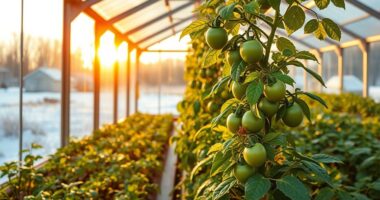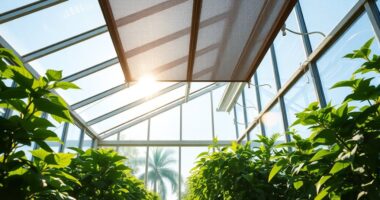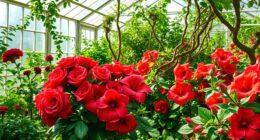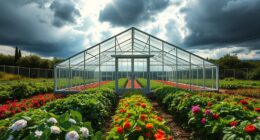To maximize greenhouse light in fall and winter, position your plants near south-facing windows and keep curtains open during the day. Use reflective surfaces to bounce light around your space and consider supplemental artificial grow lights with full-spectrum bulbs that mimic natural sunlight. Program your lights to follow the natural cycle and guarantee they’re close enough to plants without causing heat stress. For more tips on maintaining healthy plants and boosting your mood, keep exploring how to optimize your indoor environment.
Key Takeaways
- Position greenhouse plants near south-facing windows to maximize natural sunlight absorption.
- Use full-spectrum grow lights programmed to replicate natural day-night cycles for optimal plant health.
- Incorporate reflective surfaces around the greenhouse to enhance light distribution and reduce shadows.
- Keep curtains open during daylight hours and utilize midday outdoor walks to boost mood and energy.
- Combine natural sunlight with artificial lighting strategies to ensure consistent, adequate light levels year-round.
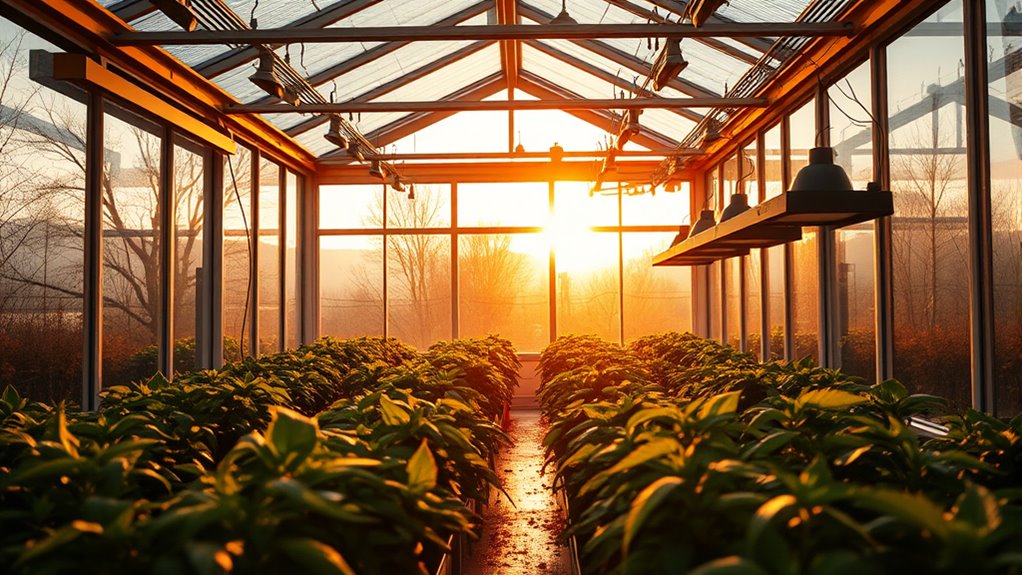
As the days grow shorter, many people notice their energy dips and mood shifts. It’s a natural response to less available natural light, especially during fall and winter. Seasonal sunlight diminishes, leaving fewer hours of daylight that can affect your mood and productivity. To counteract this, you might find yourself relying more on artificial lighting, but understanding how to maximize both natural and artificial light sources makes a real difference in maintaining your well-being and the health of your plants, especially if you’re growing indoors or managing a greenhouse.
During these months, maximizing the available seasonal sunlight is vital. Even on overcast days, try to position your plants or workspaces near south-facing windows, where they can absorb the most light. Keep your curtains open during the day to make the most of every sunbeam. If your space lacks sufficient natural light, consider supplementing with grow lights designed to mimic sunlight, guaranteeing your plants still receive the energy they need. The goal is to extend the natural light exposure as much as possible during daylight hours, which helps regulate your internal clock and supports your mood.
Maximize seasonal sunlight by positioning plants near south-facing windows and keeping curtains open during the day.
Artificial lighting becomes an essential tool as natural sunlight wanes. Installing grow lights with full-spectrum bulbs can simulate the sunlight your plants and you need for ideal growth and health. These lights can be programmed to turn on and off automatically, mimicking the natural day-night cycle, which helps keep your biological rhythm steady. When choosing artificial lighting, focus on quality and intensity—more isn’t always better, but insufficient light can hinder plant growth and leave you feeling sluggish. Position your lights close enough to your plants without causing heat stress, and consider using reflective surfaces around your grow area to bounce light more effectively.
You also want to be mindful of your daily routines. Incorporate breaks during the darker hours to get some exposure to natural light whenever possible. Even a short walk outside during midday can boost your mood and energy levels. If outdoor sunlight isn’t available, turning on your artificial lights during the day can help simulate a more natural environment, preventing your circadian rhythm from falling out of sync. Additionally, choosing appropriate lighting technology that enhances light efficiency can make a significant difference in both plant health and your well-being. Combining well-placed artificial lighting with strategic use of natural sunlight keeps your indoor space vibrant and your energy steady.
In short, managing shorter days is about making the most of what you have—leveraging seasonal sunlight when it’s available and supplementing with artificial lighting when it’s not. By doing so, you support your well-being and guarantee your plants thrive through the darker months.
Frequently Asked Questions
Can Supplemental Lighting Replace Natural Sunlight Entirely?
Artificial sunlight can’t fully replace natural sunlight, but light supplementation helps fill in gaps during shorter days. You should use artificial light strategically to guarantee your plants get enough energy, especially when natural sunlight is limited. Relying solely on light supplementation may not be ideal, but combining it with natural light creates an ideal environment. This way, your plants stay healthy and productive throughout fall and winter.
How Do I Balance Temperature and Light During Short Days?
To balance temperature and light during short days, you should monitor light intensity closely and adjust supplemental lighting accordingly to guarantee plants receive enough light without overheating. Use temperature regulation techniques like vents, fans, or heaters to keep conditions ideal. Maintaining a consistent temperature helps maximize light efficiency, preventing stress and promoting healthy growth. Regularly check both light levels and temperature, and fine-tune your systems for the best results.
Are Certain Plant Species More Tolerant of Reduced Daylight?
Yes, some plant species are more tolerant of reduced daylight, especially those with high shade tolerance and low photoperiod sensitivity. You’ll find that plants like ferns, hostas, and certain leafy greens handle shorter days better, thriving in lower light conditions. By choosing these species, you can guarantee healthier growth during fall and winter, even when daylight is limited. Adjust your greenhouse lighting strategies accordingly for ideal results.
What Are the Energy Costs Associated With Additional Greenhouse Lighting?
Did you know that greenhouse lighting can account for up to 50% of energy costs? The energy costs associated with additional greenhouse lighting vary depending on the type and efficiency of your lights. Using high-efficiency LED lighting can markedly reduce expenses, saving you up to 75% on energy compared to traditional bulbs. Optimizing lighting efficiency helps you manage costs while ensuring your plants get the light they need for healthy growth.
How Can I Prevent Plant Stress During Seasonal Light Changes?
To prevent plant stress during seasonal light changes, you should adjust your nutrient management and watering schedules accordingly. Confirm your plants receive the right balance of nutrients to support their growth and resilience, especially as light levels decrease. Maintain consistent watering, avoiding over- or under-watering, which can add stress. By fine-tuning these practices, you help your plants adapt smoothly to changing light conditions and stay healthy throughout the season.
Conclusion
As days get shorter, don’t let reduced sunlight limit your greenhouse’s productivity. By optimizing your lighting and ventilation, you can keep your plants healthy through fall and winter. Did you know that supplemental lighting can boost plant growth by up to 30% during darker months? Staying proactive guarantees your greenhouse remains a thriving oasis, regardless of the season. Embrace these strategies, and you’ll enjoy vibrant, healthy plants year-round—even when daylight is scarce.


